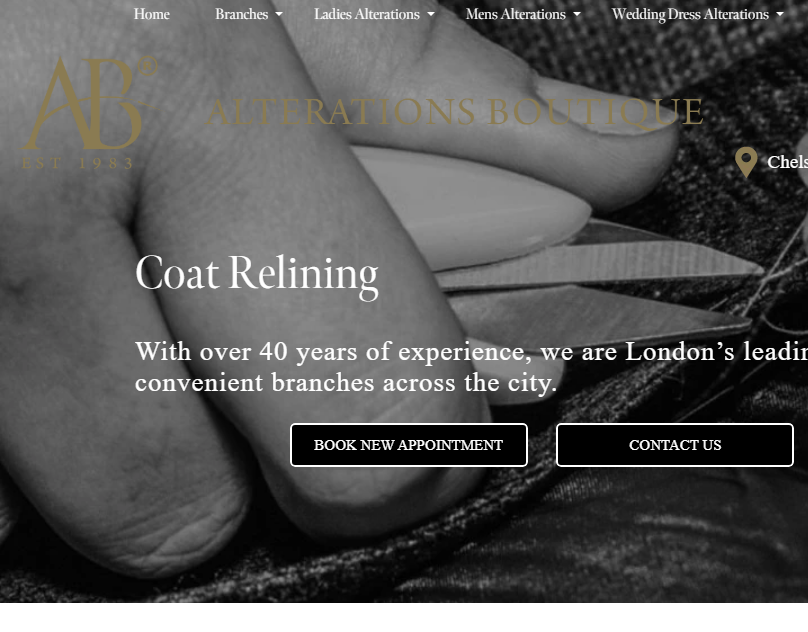Choosing the Right Lining Material for Your Coat Relining
Introduction
Coat relining is an excellent way to restore comfort, enhance style, and extend the lifespan of your favorite coat. However, one of the most important decisions in the process is selecting the right lining material. The lining plays a crucial role in how the coat feels, functions, and looks. This article will guide you through the different lining materials available and help you choose the best one for your specific needs.Alterations Boutique offers expert coat relining services, restoring comfort and durability to your favorite coats. Upgrade your coat’s interior with high-quality linings for a fresh, refined look.

Why the Right Lining Material Matters
The lining of a coat is more than just an interior layer—it affects:
- Comfort – The way the coat feels against your skin.
- Breathability – Whether the coat is suitable for warm or cold weather.
- Durability – How long the lining will last.
- Aesthetic Appeal – The overall look of the coat’s interior.
Choosing the right material ensures that your coat remains functional and stylish for years to come.
Factors to Consider When Choosing a Lining Material
Before selecting a lining fabric, consider the following:
- Purpose of the Coat – Is it a winter coat, a lightweight jacket, or a formal coat?
- Breathability Needs – Will you be wearing the coat in warm or cool weather?
- Durability – Will the coat be worn frequently, requiring a strong lining?
- Aesthetic Preference – Do you prefer a classic, subtle lining or a bold, statement fabric?
Popular Coat Lining Materials and Their Benefits
1. Silk Lining: Luxurious and Elegant
Silk is one of the most luxurious lining materials available. It offers a smooth texture, lightweight feel, and breathability.✅ Benefits:
- Soft and comfortable against the skin.
- Breathable, making it suitable for year-round wear.
- Adds an elegant touch, ideal for high-end coats.
❌ Considerations:
- Delicate and prone to tearing.
- Expensive compared to other materials.
2. Satin Lining: Smooth and Stylish
Satin is a popular alternative to silk, offering a glossy finish and smooth texture without the high cost.✅ Benefits:
- Soft and comfortable to wear.
- Gives coats a sophisticated and polished look.
- Available in many colors and patterns for customization.
❌ Considerations:
- Can be less durable than some other fabrics.
- May trap heat, making it less breathable.
3. Cotton Lining: Breathable and Comfortable
Cotton is a great choice for casual and lightweight coats, offering softness and breathability.✅ Benefits:
- Ideal for warmer climates due to its breathable nature.
- Hypoallergenic and gentle on the skin.
- Comfortable and versatile.
❌ Considerations:
- Less durable than synthetic options.
- Can wrinkle easily.
4. Polyester Lining: Durable and Affordable
Polyester is a widely used, budget-friendly lining material that is strong and long-lasting.✅ Benefits:
- Resistant to wrinkles and shrinking.
- Durable and easy to maintain.
- Less expensive than natural fabrics.
❌ Considerations:
- Less breathable than silk or cotton.
- May feel synthetic or plasticky.
5. Viscose Lining: Soft and Versatile
Viscose is a semi-synthetic fabric that combines the benefits of natural and synthetic materials.✅ Benefits:
- Feels like silk but is more affordable.
- Soft, breathable, and comfortable to wear.
- Drapes well, enhancing the coat’s structure.
❌ Considerations:
- Not as durable as polyester.
- May shrink or lose shape if not properly cared for.
6. Quilted Lining: Warm and Insulating
For winter coats, quilted linings provide extra warmth and insulation.✅ Benefits:
- Adds extra layers for superior warmth.
- Perfect for cold-weather and outdoor coats.
- Available in various thickness levels.
❌ Considerations:
- Can make the coat heavier and bulkier.
- Less breathable in warmer temperatures.
7. Fleece Lining: Soft and Cozy
Fleece is a great choice for casual and winter coats, providing a warm and cozy feel.✅ Benefits:
- Very warm and insulating.
- Soft and comfortable for everyday wear.
- Ideal for casual jackets and sportswear.
❌ Considerations:
- Can be too warm for moderate climates.
- Bulkier than other lining options.
8. Taffeta Lining: Lightweight and Wrinkle-Resistant
Taffeta is a lightweight, smooth, and slightly crisp fabric commonly used in formal coats.✅ Benefits:
- Resists wrinkles, maintaining a neat appearance.
- Lightweight, making it ideal for dress coats.
- Has a subtle sheen for a polished look.
❌ Considerations:
- Can feel stiff compared to silk or satin.
- Less insulating than quilted or fleece linings.
Choosing the Best Lining for Your Coat Type
| Coat Type | Best Lining Choices |
|---|---|
| Winter Coat | Quilted, fleece, polyester |
| Casual Jacket | Cotton, polyester, fleece |
| Formal Coat | Silk, satin, viscose, taffeta |
| Lightweight Coat | Cotton, viscose, satin |
| Vintage Coat | Silk, viscose, satin |
| Outdoor Coat | Quilted, fleece, polyester |
Customizing Your Coat Lining
Beyond selecting the material, you can personalize your coat lining by:
- Choosing a bold or patterned fabric for a stylish touch.
- Adding contrasting colors for a unique, modern interior.
- Opting for monogrammed or embroidered linings for a luxury finish.
Conclusion
Selecting the right coat lining material is essential for ensuring comfort, durability, and style. Whether you prefer the luxurious feel of silk, the durability of polyester, or the warmth of quilted linings, the right choice will transform your coat into a functional and fashionable piece. By considering factors such as climate, purpose, and budget, you can make an informed decision and enjoy a refreshed, stylish, and long-lasting coat.
